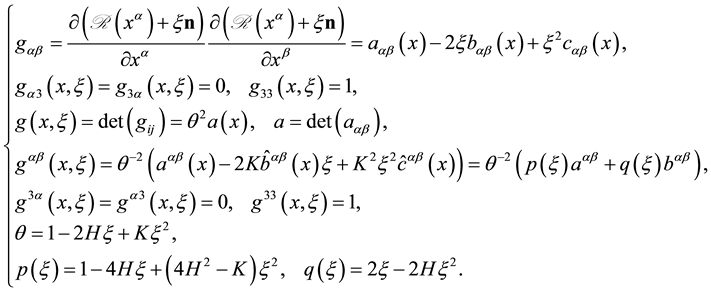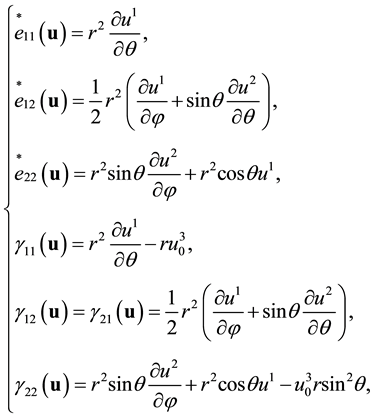International Journal of Modern Nonlinear Theory and Application
Vol.04 No.01(2015), Article ID:54881,39 pages
10.4236/ijmnta.2015.41005
The Boundary Layer Equations and a Dimensional Split Method for Navier-Stokes Equations in Exterior Domain of a Spheroid and Ellipsoid
Jian Su1, Hongzhou Fan2, Weibing Feng3, Hao Chen4, Kaitai Li1
1School of Mathematics and Statistic, Xi’an Jiaotong University, Xi’an, China
2School of Energy and Power Engineering, Xi’an Jiaotong University, Xi’an, China
3School of Computer Engineering and Science, Shanghai University, Shanghai, China
4School of Mechanics and Engineering, Southwest Jiaotong University, Chengdu, China
Email: ktli@mail.xjtu.edu.cn
Copyright © 2015 by authors and Scientific Research Publishing Inc.
This work is licensed under the Creative Commons Attribution International License (CC BY).
http://creativecommons.org/licenses/by/4.0/



Received 22 February 2015; accepted 15 March 2015; published 20 March 2015
ABSTRACT
In this paper, the boundary layer equations (abbreviation BLE) for exterior flow around an obstacle are established using semi-geodesic coordinate system (S-coordinate) based on the curved two dimensional surface of the obstacle. BLE are nonlinear partial differential equations on unknown normal viscous stress tensor and pressure on the obstacle and the existence of solution of BLE is proved. In addition a dimensional split method for dimensional three Navier-Stokes equations is established by applying several 2D-3C partial differential equations on two dimensional manifolds to approach 3D Navier-Stokes equations. The examples for the exterior flow around spheroid and ellipsoid are presents here.
Keywords:
Boundary Layer Equations, Dimensional Split Method, Navier-Stokes Equations, Dimensional Two Manifold

1. Introduction
In computational fluid dynamics, one need to compute the drag exerted on a body in flow field; in particular, optimal shape design has received considerable attention already, see Li and Huang [1] , Li, Chen and Yu [2] , and Li, Su, Huang [3] . It has become vast enough to branch into several disciplines on the theoretical side, many results deal with the existence of solutions to the problem or its relaxed form, on the practical side, topological shape  optimization which solves numerically the relaxed problem or by local shape variation. In this case
optimization which solves numerically the relaxed problem or by local shape variation. In this case
we have to compute the velocity gradient  along the normal to the surface of the boundary and normal
along the normal to the surface of the boundary and normal
stress tensor  to the surface. All those computation have to do in the boundary layer. Therefore this leads to make very fine mash; for example, 80% nodes will be concentred in a neighborhood of the surface of the body.
to the surface. All those computation have to do in the boundary layer. Therefore this leads to make very fine mash; for example, 80% nodes will be concentred in a neighborhood of the surface of the body.
In this paper a boundary layer equations for  on the surface will be established using local
on the surface will be established using local
semi-geodesic coordinate system based on the surface, provide the computational formula for the drag func- tional. In addition, a dimensional split method for three dimensional Navier-Stokes equations is established by applying several 2D-3C partial differential equations on the two dimensional manifolds to approximate 3D Navier-Stokes equation.
The Dimensional Slitting Methods deal, for examples, with thin domain problem as elastic shell (see Ciarlet [4] , Li, Zhang and Huang [5] ), Temam and Ziane [6] , and with boundary value problem with complexity boun- dary geometry (see [7] -[10] ).
The content of the paper is organized as the followings. Section 2 establishes semi-geodesic coordinate system and related the Navier-Stokes equations; Section 3 assumes that the solutions of Navier-Stokes equa- tions in the boundary layer can be made Taylor expansion with respect to transverse variable, derive the equations for the terms of Taylor expansion; Section 4 proves the existence of the solutions of the BLE; Section 5 provides the computational formula of the drag functional; Section 6 provide a dimensional splitting method for 3D Navier-Stokes equations; Section 7 provide some examples.
2. Navier-Stokes Equations and Its Variational Formulation in a Semi-Geodesic Coordinate System
Through this paper, we consider state steady incompressible Navier-Stokes equations and its variational formu- lation in a thin domain , a strip with thickness
, a strip with thickness  and by a Lipchsitz continuous boundary
and by a Lipchsitz continuous boundary
 ,
,
 (2.1)
(2.1)
or
 (2.1')
(2.1')
which are invariant form in any curvilinear coordinate system. Let

At first, we introduce semi-geodesic coordinate system (abbreviation S-coordinate). As well known thhat boundary layer  in 3D Euclidean space bounded by
in 3D Euclidean space bounded by  and
and  where
where  is bottom of the boundary layer, a surface of solid boundary of the flow fluid, and
is bottom of the boundary layer, a surface of solid boundary of the flow fluid, and  is a top boundary of
is a top boundary of , an artificial interface of the flow fluid where
, an artificial interface of the flow fluid where 


thickness of the strip, the boundary layer. Assume that there exits a smooth immersion 





obvious that 

fundamental form and third fundamental form which coefficients are metric tensor 



Their contravariant components 
What’s follows that we will frequently used the inverse matrix 

Now, assume that there exists an unique normal vector 


where 





is called semi-geodesic coordinate based on the surface



Therefore, the metric tensor of 

Figure 1. The diagram of semi-geodesic coor- dinate system.

(see ref. [1] ) wherre 



on, denote 





In addition, we review the main notation. Greek indices and exponents belong to the set

used. Symbols such as 






thermore, the physical or geometric quantities with the asterisk 








There are following relations of the first,second and third fundamental forms (ref. [1] )
The following give the relations of differential operators in the space and on 



and covariant derivatives of the vector field are given by
where 



Of course,





The strain tensors of the vectors in 


where

In the semi-geodesic coordinate system (see next section), define the bilinear form 

Then, the primitive variable variational formulation for Navier-Stokes Equations (2.1') is given by

while the Navier-Stokes Equations (2.7) in semi-geodesic coordinate system are expressed as


3. Boundary Layer Equations
Assume that 



It is obvious that 





Domain 
Assumption AI assume that the solutions 



In same time, the test vector also can be made Taylor expansion
Theorem 1 In a boundary layer domain 



and five algebraic equations

Associated variational formulations with (3.2) is given by

where the bilinear forms defined by

and

where



Next, let consider interface equation. In this case 
Assumption AII Assume that the solutions 




Theorem 2 Assume that the Assumption II is satisfied. Then six unknown of 


The right terms

In particular, for flexible (slip condition


The Proof of Theorems 1 and 2 is neglected.
4. The Existence of the Solution
In this section we prove the existence of the weak solution of (3.2). To do that we consider variational
formulation of (3.2). Let 

dic boundary condition. Since ([14] , Th.1.8.6) we claim
where
Let define bilinear form:

where 

Then corresponding variational formulation for (3.2) is given by

where

Lemma 1 Assume that the metric tensor and curvature tensor of 










Therefore,

Furthermore, If 



Proof The proof of (4.4) can be found in ([1] [4] ). It remain to prove (4.6). By virtue of the positive definition of metric tensor 
where 


Lemma 2 Assume that the two-dimensional manifold 







where 


then they are also coercive respectively

where 

Proof Indeed it is enough to prove the coerciveness (4.8) since the continuous and symmetric are obvious by Hoelder inequality. Since Lemma 1,
In view of Korn inequality on Riemann manifold (see [4] Th.1.7.9 )
we assert that

if 

Next we consider variational problem (4.2) corresponding to boundary layer Equation (3.4). Let

Lemma 3 Assume that the manifold 

The thickness 


where 

where 


Proof It is easy to verify (4.12) by applying Hoelder inequality and Poincare inequality. It remains to prove (4.13). At the first, we recall that the assumptions of the lemma shows
Taking (4.8) into account, from (4.10) it infers

(1) Since Lemma 1 and (4.3) we have
Moreover, using Godazzi formula
Therefore
Thanks to

We assert that
Second inequality shows

Using Young inequality
we have

By similar manner,


Substituting (4.18-4.20) into (4.16) leads to

Taking (4.9) into account, it yield

If

Then

It is easy to verify that (4.23) is satisfied if the parameters 

Next we consider trilinear form. Taking into account of
we claim that
By Ladyzhenskya inequality (Temam [11] )

it infers that

Combing (4.15) (4.24) and (4.27), we obtain

This complete our proof.
Theorem 3 Assume that the hypotheses in Lemma 3 are satisfied and the mapping
is sequentially weakly continuous in
Then there exists at least one solution 

where 

Proof We begin with constructing a sequence of approximate solutions by Galerkin’s method. Since the space 











Setting
Problem (4.30) is equivalent to a system of nonlinear equations with m unknowns


where 



it follows from (4.28)
Let 

if 

if

Hence, we conclude

Moreover, 

Lemma 4 Let 







Then, there exists an element 


Therefore there exists a solution 

This shows that the sequence (


Then, the compactness of the embedding of 

Since 

Taking the limit of both sides of (4.30) implies
therefore
Then 
The proof is complete.
Remark The mapping 

5. Dimensional Split Method for Exterior Flow Problem around an Obstacle and a Two Scale Parallel Algorithms
In this section, we proposal a dimensional split algorithm for the three dimensional exterior flow around a obstacle occupied by







On every surface


where right terms are given by
The features of these systems are that the right terms of them depend upon the solution of next system, for example, the right term of kth-system depend upon the solution of 
(1) Suppose that right hands
(2) Solve system of
(3) Modifying 
In order to find solution of Navier-Stokes equations at any point P in Exterior domain
(i) Identify point P in which stream layer 


(ii)
where 

In details,
(I) For 



and six unknown 

Associated variational formulations with (5.1) is given by

where 

and

The right terms are given by

where
(II) For






On the other hand we can improve (5.7). To do that, making covariant derivative 



The variational formulations corresponding to (5.7) and (5.1) are given respectively by

and

where the bilinear forms and linear form are defined by

(III) For 






(1) Let 





coordinate on




while the metric tensor 


where

On other hand, we show
Indeed,
Finally we imply

where 



(2). Let assume that the flow outside of 













where 

where for

where 
Then integral expressions of solutions of Oseen problem (5.9) are given by

where 
Here we employ Cartesian coordinate system 

dimensional manifold. The integrate representation (5.17) of the solution of Oseen problem is invariant, it is valid for any curvature coordinate. Since formula for fundamental solution 
Vector 







Normal stress tensor 


(5.23) can be rewrite in semi-geodesic coordinate based on

where, 




Lemma 5 The bilinear form 

Theorem 4 Assume that 


Parallel algorithms. The Domain ia made partition by m interfaces surfaces and we obtain 
6. Computation of the Drag
The drag is a force exerted on a solid boundary surface, for example,


The drag is a projection of normal stress on the direction of infinite stream flow

Since unit normal vector at 


Therefore
As well known that the stress tensor is given by
At surface
Since
because of
Hence

The drag is a force exerted on a solid boundary surface, for example,





where 

7. Examples
7.1. The Flow around a Sphere
Assume that 

Simple calculations show that the metric tensor of spherical surface

The tensor of second fundamental form, i.e. curvature tensor of spherical surface is given by

the base vectors of semi-geophysical coordinate system are given

We remainder have to give the covariant derivatives of the velocity field, Laplace-Betrami operator and trace-Laplace operator. To do this we have to give the first and second kind of Christoffel symbols on the spherical surface 
Then covariant derivatives of vector 

Nonlinear terms
and
The associated Laplace-Betrami operator and divergence operator on 

while trace-Laplace operator on

(A) BLE I
Substituting previous formula into Theorem 1 we assert that

In particular, if the flow is axial symmetric then

where
(5.7) is a two points boundary value problem for ordinary differential equations.


(B) SLE II
The first, we note
So that
Taking (5.7) into account, we claim that
(7.10)
If the flow is symmetric then

and
(7.12)
where

The drag is given by

7.2. The Flow around an Ellipsoid
Let parametric equation of the ellipsoid be given by

where 


The metric tensor of the ellipsoid is given by

Curvature tensor, mean curvature and Gaussian curvature are given by

Semi-Geodesic Coordinate System Based on Ellipsoid
That is
The radial vector at any point in
Corresponding metric tensor of 

Then covariant derivatives of vector 

The associated Laplace-Betrami operator on

Trace-Laplace operatoe on

In addition, nonlinear terms

and linear terms

(i) BLE I. Taking (5.1-5.6) and above formula into account we obtain BLE I on the ellipsoid

where


The right terms are given by

(ii) SEL II. Let consider SEL II given by (5.7) and corresponding variational formulation (5.12) which are followings in semi geodesic coordinate system based on the ellipsoid
(7.27)
where



Calculation of Drag Assume that

(iii) Axial symmetry Case. If


The covariant derivatives become



Let
Then BLE I (7.23) and SLE II (7.27) become

where

The drag is given by

In the following we concern with the axi-symmetric flow around an ellipsoid, which depends significantly on the Reynolds number and the geometry of the ellipsoid. And the boundary layer equations are solved with spectral method. The fluid approaches the ellipsoid with a uniform free-stream velocity from inlet to outlet. In order to compare with the results in reference conveniently, the results should be dimensionless. Therefore the other parametric equation of ellipsoid is proposed
where 




The Reynolds number based on the focal length, i.e.
focal length 

where 

Therefore the total drag coefficient is also decomposed into pressure and viscous part:
Firstly the numerical solution of boundary layer equations is validated quantitatively by comparison with results in references and finite element method. Table 1 presents results of pressure and total drag coefficients for various Reynolds numbers at


Badr [13] are both achieved. And the normal stress tensor 
considered as the boundary condition of boundary layer equations, which is obtained from the solutions of finite element method. According to Table 1 and Table 2 the precision of drag computation with boundary layer equations is higher than the finite element method, so the boundary layer equations could be used to improve the computation precision of flow in the boundary layer with low cost.
Figure 2 presents the nearly stationary streamline patterns and pressure distributions at different Reynolds numbers 10, 30, 60 and 100 respectively for

Figure 3 presents the nearly stationary streamline patterns and pressure distributions at different 



Figure 2. Streamlines of the flow:(a)




Table 1. Comparison of drag coefficients for various Reynolds numbers at
Then the flow details around the trailing edge of ellipsoid for



Figure 5 shows shows the surface dimensionless pressure distributions for the case 

Figure 6 proposes the corresponding pressure distributions in 3D.


Figure 3. Streamlines of the flow: (a)





Figure 4. Comparison of flow details for

Figure 5. Surface pressure distribution for


Figure 6. Surface pressure distribution in 3D: (a)




The effect of 



be expected. The surface pressure distributions are compared between FEM and BLE in Figure 8 for the case 

Figure 9 proposes the corresponding pressure distributions in 3D.
Figure 7. Surface pressure distribution for


Figure 8. Comparison of surface pressure distribution between FEM and BLE: (a)






Figure 9. Surface pressure distribution in 3D: (a)




Table 2. Comparison of drag coefficients for various values of 

Finally, it has to be emphasized that since flow axisymmetry is assumed in the present study, none of our results give any indication about symmetry-breaking in a real flow. The presented method are, however, not restricted to axi-symmetric flow, the BLE I aforementioned could be used to compute the non-axisymmetric flow.
Support
Supported by Major Research Plan of NSFC (91330116), National Basic Research Program No 2011CB 706505, NSFC 11371288, 11371289.
References
- Li, K.T. and Huang, A.X. (2013) Boundary Shape Control of Navier-Stokes Equations and Dimensional Splitting Methods and Its Applications. Science Press, Beijing (in Chinese).
- Li, K.T., Chen, H. and Yu, J.P. (2013) An New Boundary Layer Equations and Applications to Shape Control. Scientia Sinica (Mathematics), 43, 965-1021 (in Chinese). http://dx.doi.org/10.1360/012012-428
- Li, K.T., Su, J. and Huang, A.X. (2010) Boundary Shape Control of the Navier-Stokes Equations and Applications. Chinese Annals of Mathematics, 31B, 879-920.
- Ciarlet, P.G. (2000) Mathematical Elasticity, Vol. III: Theory of Shells. North-Holland, Amsterdam.
- Li, K.T., Zhang, W.L. and Huang, A.X. (2006) An Asymptotic Analysis Method for the Linearly Shell Theory. Science in China, Series A, 49, 1009-1047.
- Temam, R. and Ziane, M. (1997) Navier-Stokes Equations in Thin Spherical Domains. Contemporary Mathematics, 209, 281-314. http://dx.doi.org/10.1090/conm/209/02772
- Li, K.T., Yu, J.P. and Liu, D.M. (2012) A Differential Geomety Methods for Rational Navier-Stokes Equations with Complex Boundary and Two Scales Paralelell Algorithms. Acta Mathematicae Applicae Sinica, 35, 1-41.
- Li, K.T., Huang, A.X. and Zhang, W.L. (2002) A Dimension Split Method for the 3-D Compressible Navier-Stokes Equations in Turbomachine. Communications in Numerical Methods in Engineering, 18, 1-14.
- Li, K.T. and Liu, D.M. (2009) Dimension Splitting Method for 3D Rotating Compressible Navier-Stokes Equations in the Turbomachinery. International Journal of Numerical Analysis and Modeling, 6, 420-439.
- Li, K.T., Yu, J.P., Shi, F. and Huang, A.X. (2012) Dimension Splitting Method for the Three Dimensional Rotating Navier-Stokes Equations. Acta Mathematicae Applicatae Sinica―English Series, 28, 417-442. http://dx.doi.org/10.1007/s10255-012-0161-7
- Temam, R. (1984) Navier-Stokes Equations, Theorem and Numerical Ananlysis. North Holland, Amsterdam, U.S.A., New York.
- Giraut, V. and Raviart, P.A. (1985) Finite Element Approximation of the Navier-Stokes Equations. Springer-Verlag, Berlin.
- Alassar, R.S. and Badr, H.M. (1999) Oscillating Flow over Oblate Spheroids. Acta Mechanica, 137, 237-254. http://dx.doi.org/10.1007/BF01179212
- Rimon, Y. and Cheng, S.I. (1969) Numerical Solution of a Uniform Flow over a Sphere at Intermediate Reynolds Numbers. Physics of Fluids, 12, 949-959. http://dx.doi.org/10.1063/1.2163685






















































































































